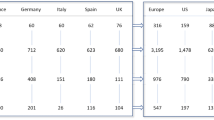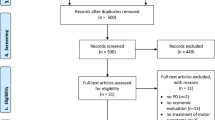Abstract
Objective: To prospectively evaluate the health economic burden of patients with Parkinson’s disease (PD) in Germany over a 6-month observation period and to identify the predictors of these costs.
Study design and methods: Direct and indirect costs were evaluated in 145 patients with PD (mean age 67.3 ± 9.6 years). PD patients were recruited from an outpatient department for movement disorders, a specialised PD clinic, two office-based neurologists and general practitioners, all located in Germany, and were enrolled between January and June 2000. Relevant economic data were documented in a patient diary over the 6-month period. Clinical evaluations (Unified Parkinson’s Disease Rating Scale [UPDRS]) were performed at baseline and at 3 and 6 months. Costs were derived from various German medical economic resources. Costs were calculated from the perspective of healthcare and transfer payment providers and the individual patient. Indirect costs for lost productivity were also calculated. Costs are presented as means ± standard deviation (SD). Multivariate regression analyses were performed to identify independent cost predictors. Costs are in year 2000–02 values.
Results: We estimated average per patient direct, indirect and total costs for the 6-month observation period. The costs from the perspective of statutory health insurance (Gesetzliche Krankenkversicherung [GKV]) consisted of direct medical costs €1370 ± €3240, including rehabilitation (€420 ± €1630), hospitalisation (€710 ± €2520), outpatient treatment (€40 ± €30), ancillary treatment (€190 ± €280) and ambulatory diagnostic procedures (€10 ± €30). In addition, parkinsonian drug costs were €1520 ± €1250. Non-medical direct costs calculated from the GKV perspective were estimated to be €480 ± €1710, which included transportation (€10 ± €20), special equipment (€420 ± €1640), social/home-help services (€10 ± €110) and sickness benefit (€40 ± €540). The total medical (including drug costs) and non-medical direct costs for the GKV were €3380 ± €4230. Univariate predictors for GKV direct costs included occurrence of motor complications and falls, disease severity, nightmares and dementia. However, multivariate analyses only suggested disease severity and health-related quality of life as significant predictors. For nursing insurance, payments of €1330 ± €2890 were calculated. For retirement insurance, payments were €650 ± €1510 and there were patient (or caregiver) costs of €1490 ± €2730. Total indirect costs amounted to €3180 ± €6480.
Conclusion: According to our study, PD puts a high financial burden on society and underscores the need for further economic and medical research to optimise treatment for PD.







Similar content being viewed by others
References
Rajput AH, Offord KP, Beard CM, et al. Epidemiology of parkinsonism: incidence, classification, and mortality. Ann Neurol 1984; 16 (3): 278–82
Oertel WH, Quinn NP. Parkinsonism. In: Brandt T, Diener HC, Caplan LR, et al., editors. Neurological disorders: course and treatment. San Diego (CA): Academic Press, 2003: 715–72
Rinne UK. Problems associated with long-term levodopa treatment of Parkinson’s disease. Acta Neurol Scand Suppl 1983; 95: 19–26
Fahn S. The spectrum of levodopa-induced dyskinesias. Ann Neurol 2000; 47 (4 Suppl. 1): S2–9
Ahlskog JE, Muenter MD. Frequency of levodopa-related dyskinesias and motor fluctuations as estimated from the cumulative literature. Mov Disord 2001; 16 (3): 448–58
Cummings JL, Masterman DL. Depression in patients with Parkinson’s disease. Int J Geriatr Psychiatry 1999; 14 (9): 711–8
Tandberg E, Larsen JP, Aarsland D, et al. The occurrence of depression in Parkinson’s disease: a community-based study. Arch Neurol 1996; 53 (2): 175–9
Mayeux R, Denaro J, Hemenegildo N, et al. A population-based investigation of Parkinson’s disease with and without dementia: relationship to age and gender. Arch Neurol 1992; 49 (5): 492–7
Rajput AH, Offord K, Beard CM, et al. Epidemiological survey of dementia in parkinsonism and control population. Adv Neurol 1984; 40: 229–34
Aarsland D, Tandberg E, Larsen JP, et al. Frequency of dementia in Parkinson disease. Arch Neurol 1996; 53 (6: 538–42
Golbe LI. Young-onset Parkinson’s disease: a clinical review. Neurology 1991; 41 (2 Pt 1): 168–73
Dodel RC, Singer M, Kohne-Volland R, et al. The economic impact of Parkinson’s disease: an estimation based on a 3-month prospective analysis. Pharmacoeconomics 1998; 14 (3): 299–312
Dodel RC, Singer M, Kohne-Volland R, et al. Cost of illness in Parkinson disease: a retrospective 3-month analysis of direct costs. Nervenarzt 1997; 68 (12): 978–84
Chrischilles EA, Rubenstein LM, Voelker MD, et al. The health burdens of Parkinson’s disease. Mov Disord 1998; 13 (3): 406–13
Haycock J. Idiopathic Parkinson’s disease: the burden of illness [Dissertation]. York: University of York, 1992
Rubenstein LM, Chrischilles EA, Voelker MD. The impact of Parkinson’s disease on health status, health expenditures, and productivity: estimates from the National Medical Expenditure Survey. Pharmacoeconomics 1997; 12 (4): 486–98
Singer E. Social costs of Parkinson’s disease. J Chronic Dis 1973; 26 (4): 243–54
Whetten-Goldstein K, Sloan F, Kulas E, et al. The burden of Parkinson’s disease on society, family, and the individual. J Am Geriatr Soc 1997; 45 (7): 844–9
LePen C, Wait S, Moutard-Martin F, et al. Cost of illness and disease severity in a cohort of French patients with Parkinson’s disease. Pharmacoeconomics 1999; 16 (1): 59–69
Dodel RC, Berger K, Oertel WH. Health-related quality of life and healthcare utilisation in patients with Parkinson’s disease: impact of motor fluctuations and dyskinesias. Pharmacoeconomics 2001; 19 (10): 1013–38
Gibb WRG. Accuracy in the clinical diagnosis of parkinsonian syndromes. Postgrad Med J 1988; 64: 345–51
Beck A, Ward CH, Mendelson M, et al. An inventory for measuring depression. Arch Gen Psychiatry 1961; 4: 561–7
Folstein MF, Folstein SE, McHugh PR. “Mini-mental state”: a practical method for grading the cognitive state of patients for the clinician. J Psychiatr Res 1975; 12 (3): 189–98
Peto V, Jenkinson C, Fitzpatrick R. PDQ-39: a review of the development, validation and application of a Parkinson’s disease quality of life questionnaire and its associated measures. J Neurol 1998; 245 Suppl. 1: S10–4
de Boer AG, Wijker W, Speelman JD, et al. Quality of life in patients with Parkinson’s disease: development of a questionnaire. J Neurol Neurosurg Psychiatr 1996; 61 (1): 70–4
Claes C, Greiner W, Uber A. Der EQ-5D als krankheitsübergreifendes indexinstrument. In: Schöffski O, Schulenburg v JM, editors. Gesundheits6konomische Evaluationen. Berlin: Springer, 2000: 351–65
Bundesverband der pharmazeutischen industrie. Rote Liste. Weinheim: Rote Liste Verlag, 2002
Deutscher Ärzteverlag. Einheitlicher Bewertungsmasstab. Köln: Deutscher Ärzteverlag, 2001
Hoffmann C, Schöffski O, von Schulenburg JM. Deutsche Empfhlungen zur gesundheitsökonomischen Evaluation. In: Schöffski O, von Schulenburg JM. Gesundheitsökonomische Evaluationen. Berlin: Springer, 2000: 426–66
Harrell FE. Regression modeling strategies. New York: Springer, 2002
Hoehn M, Yam MD. Parkinsonism: onset, progression and mortality. Neurology 1967; 17 (5): 427–42
Keller S, Kessler T, Meuser T, et al. Analysis of direct costs in therapy of Parkinson disease. Nervenarzt 2003; 74 (12): 11059
Hagell P, Nordling S, Reimer J, et al. Resource use and costs in a Swedish cohort of patients with Parkinson’s disease. Mov Disord 2002; 17 (6: 1213–20
Keranen T, Kaakkola S, Sotaniemi K, et al. Economic burden and quality of life impairment increase with severity of PD. Parkinsonism Relat Disord 2003; 9 (3): 163–8
Findley L, Aujla M, Bain PG, et al. Direct economic impact of Parkinson’s disease: a research survey in the United Kingdom. Mov Disord 2003; 18 (10): 1139–45
Guttman M, Slaughter PM, Theriault ME, et al. Burden of parkinsonism: a population-based study. Mov Disord 2003; 18 (3): 313–9
Berger K, Breteler MM, Helmer C, et al. Prognosis with Parkinson’s disease in Europe: a collaborative study of populationbased cohorts. Neurologic Diseases in the Elderly Research Group. Neurology 2000; 54 (11 Suppl. 5): S24–7
Haycock J. Idiopathic Parkinson’s disease: the burden of illness. York: University of York, 1992
MacMahon DG, Findley L, Holmes J, et al. The true economic impact of Parkinson’s disease: a research survey in the UK. Mov Disord 2000; 15 Suppl. 3: 178–9
Späte HF, Gemende G, Gemende I. Psychosoziale Aspekte der Langzeitbetreuung von Parkinsonkranken. Psychiatr Neurol Med Psychol (Leipz) 1988; 40: 385–94
Bundesministerium für Gesundheit. Daten des Gesundheitswesen. Baden-Baden: Nomos-Verlag, 1995
Clarke CE, Zobkiw RM, Gullaksen E. Quality of life and care in Parkinson’s disease. Br J Clin Pract 1995; 49 (6: 288–93
Schwabe U, Paffrath D. Arzneiverordnungsreport 2002. Berlin: Springer, 2003
Anonymous. Gebührenordnung für Ärzte (GOÄ). Stuttgart: Nomos-Verlag, 2002
Dodel RC, Haacke C, Zamzow K, et al. Resource utilization and costs of stroke unit care in Germany. Value Health 2004; 7 (2): 144–52
Kurlan R, Clark S, Shoulson I, et al. Economic impact of protective therapy for early Parkinson’s disease [abstract]. Ann Neurol 1988; 24 (1): 153
Acknowledgements
We would like to thank Mrs Siepe, as well as Karin Wissner and Günter Nitsch, from the Kompetenznetzwerk Parkinson-Syndrome. This study received support from the German Ministry of Education and Research through award number BMBF Nr. 01GI9901/1.
The roles played by each author in the conduct of the study were as follows: EA Spottke, development of the questionnaires, recruitment of the study centres, examination of the patients, preparation of the manuscript, review of the cost results; M Reuter, examination of the patients; O Machat and R Koehne-Volland, basic statistical analysis; B Bornschein and U Siebert, multivariate analysis and description of this analysis in the manuscript; S von Campenhausen and K Berger, cost research and analysis; J Rieke and A Simonow, recruitment of patients for the office-based neurologist group; D Brandstaedter and G Ulm, recruitment of patients at the Elena clinic; WH Oertel, review of the manuscript; and R Dodel, project leader, development of the questionnaires, preparation of the manuscript, review of the cost results.
The authors have no conflicts of interest that are directly relevant to the content of this review.
Author information
Authors and Affiliations
Corresponding author
Rights and permissions
About this article
Cite this article
Spottke, A.E., Reuter, M., Machat, O. et al. Cost of illness and its predictors for Parkinson’s disease in Germany. Pharmacoeconomics 23, 817–836 (2005). https://doi.org/10.2165/00019053-200523080-00007
Published:
Issue Date:
DOI: https://doi.org/10.2165/00019053-200523080-00007




